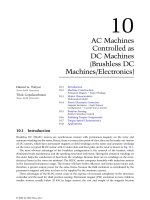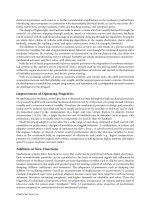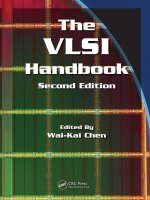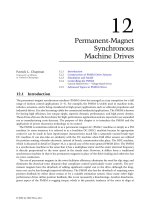The VLSI Handbook P1
Bạn đang xem bản rút gọn của tài liệu. Xem và tải ngay bản đầy đủ của tài liệu tại đây (790.21 KB, 30 trang )
The
VLSI
Handbook
Second Edition
4199_C000.fm Page i Tuesday, November 14, 2006 5:30 PM
The Electrical Engineering Handbook Series
Series Editor
Richard C. Dorf
University of California, Davis
Titles Included in the Series
The Handbook of Ad Hoc Wireless Networks,
Mohammad Ilyas
The Avionics Handbook, Second Edition,
Cary R. Spitzer
The Biomedical Engineering Handbook
,
Third Edition,
Joseph D. Bronzino
The Circuits and Filters Handbook, Second Edition
, Wai-Kai Chen
The Communications Handbook, Second Edition,
Jerry Gibson
The Computer Engineering Handbook,
Vojin G. Oklobdzija
The Control Handbook
, William S. Levine
The CRC Handbook of Engineering Tables,
Richard C. Dorf
The Digital Avionics Handbook
, Second Edition Cary R. Spitzer
The Digital Signal Processing Handbook
, Vijay K. Madisetti and Douglas Williams
The Electrical Engineering Handbook
,
Second Edition,
Richard C. Dorf
The Electric Power Engineering Handbook
, Leo L. Grigsby
The Electronics Handbook
,
Second Edition,
Jerry C. Whitaker
The Engineering Handbook, Third Edition
, Richard C. Dorf
The Handbook of Formulas and Tables for Signal Processing
, Alexander D. Poularikas
The Handbook of Nanoscience, Engineering, and Technology,
William A. Goddard, III,
Donald W. Brenner, Sergey E. Lyshevski, and Gerald J. Iafrate
The Handbook of Optical Communication Networks,
Mohammad Ilyas and Hussein T. Mouftah
The Industrial Electronics Handbook
, J. David Irwin
The Measurement, Instrumentation, and Sensors Handbook
, John G. Webster
The Mechanical Systems Design Handbook
, Osita D.I. Nwokah and Yidirim Hurmuzlu
The Mechatronics Handbook
, Robert H. Bishop
The Mobile Communications Handbook
,
Second Edition
, Jerry D. Gibson
The Ocean Engineering Handbook
, Ferial El-Hawary
The RF and Microwave Handbook
, Mike Golio
The Technology Management Handbook
, Richard C. Dorf
The Transforms and Applications Handbook
,
Second Edition,
Alexander D. Poularikas
The VLSI Handbook
,
Second Edition
, Wai-Kai Chen
4199_C000.fm Page ii Tuesday, November 14, 2006 5:30 PM
Edited by
Wai-Kai Chen
University of Illinois
Chicago, USA
CRC Press is an imprint of the
Taylor & Francis Group, an informa business
Boca Raton London New York
4199_C000.fm Page iii Tuesday, November 14, 2006 5:30 PM
CRC Press
Taylor & Francis Group
6000 Broken Sound Parkway NW, Suite 300
Boca Raton, FL 33487-2742
© 2007 by Taylor & Francis Group, LLC
CRC Press is an imprint of Taylor & Francis Group, an Informa business
No claim to original U.S. Government works
Printed in the United States of America on acid-free paper
10 9 8 7 6 5 4 3 2 1
International Standard Book Number-10: 0-8493-4199-X (Hardcover)
International Standard Book Number-13: 978-0-8493-4199-1 (Hardcover)
This book contains information obtained from authentic and highly regarded sources. Reprinted material is quoted with
permission, and sources are indicated. A wide variety of references are listed. Reasonable efforts have been made to publish
reliable data and information, but the author and the publisher cannot assume responsibility for the validity of all materials
or for the consequences of their use.
No part of this book may be reprinted, reproduced, transmitted, or utilized in any form by any electronic, mechanical, or other
means, now known or hereafter invented, including photocopying, microfilming, and recording, or in any information storage
or retrieval system, without written permission from the publishers.
For permission to photocopy or use material electronically from this work, please access www.copyright.com (http://
www.copyright.com/) or contact the Copyright Clearance Center, Inc. (CCC) 222 Rosewood Drive, Danvers, MA 01923,
978-750-8400. CCC is a not-for-profit organization that provides licenses and registration for a variety of users. For
organizations that have been granted a photocopy license by the CCC, a separate system of payment has been arranged.
Trademark Notice:
Product or corporate names may be trademarks or registered trademarks, and are used only for
identification and explanation without intent to infringe.
Visit the Taylor & Francis Web site at
and the CRC Press Web site at
Library of Congress Cataloging-in-Publication Data
The VLSI handbook / edited by Wai-Kai Chen.—2nd ed.
p. cm.—(Electrical engineering handbook series; 38)
Includes bibliographical references and index.
ISBN 0-8493-4199-X
1. Integrated circuits—Very large scale integration. I. Chen, Wai-Kai, 1936- II. Title. III. Series.
TK7874.75.V573 2006
621.39´5—dc22 2006050477
4199_C000.fm Page iv Tuesday, November 14, 2006 5:30 PM
v
Preface
We are most gratified to find that the first edition of
The VLSI Handbook
(2000) was well received and
is widely used. Thus, we feel that our original goal of providing in-depth professional-level coverage of
VLSI technology was, indeed, worthwhile. Seven years is a short time in terms of development of science
and technology; however as this handbook shows, momentous changes have occurred during this period,
necessitating not only the updating of many chapters of the handbook, but more startling, the addition
and expansion of many topics. Significant examples are low-power electronics and design, testing of
digital systems, VLSI signal processing, and design languages and tools to name a few of the more
prominent additions.
Purpose
The VLSI Handbook
provides in a single volume a comprehensive reference work covering the broad
spectrum of VLSI technology. It is written and developed for practicing electrical engineers in industry,
government, and academia. The goal is to provide the most up-to-date information in integrated
circuits (IC) technology, devices and their models, circuit simulations, low-power electronics
and design, amplifiers, analog and logic circuits, memory, registers and system timing, microprocessor
and ASIC, test and testability, design automation, VLSI signal processing, and design languages and
tools. The handbook is not an all-encompassing digest of everything taught within an electrical
engineering curriculum on VLSI technology. Rather, it is the engineer’s first choice in looking for a
solution. Therefore, full references to other sources of contributions are provided. The ideal reader is
a BS level engineer with a need for a one-source reference to keep abreast of new techniques and
procedures as well as review standard practices.
Background
The handbook stresses fundamental theory behind professional applications. To do so, it is reinforced
with frequent examples. Extensive development of theory and details of proofs have been omitted. The
reader is assumed to have a certain degree of sophistication and experience. However, brief reviews of
theories, principles, and mathematics of some subject areas are given. These reviews have been done
concisely with perception. The handbook is not a textbook replacement, but rather a reinforcement and
reminder of material learned as a student. Therefore, important advancement and traditional as well as
innovative practices are included.
Since most of the professional electrical engineers graduated before powerful personal computers were
widely available, many computational and design methods may be new to them. Therefore, computers
and software use are thoroughly covered. Not only does the handbook use traditional references to cite
sources for the contributions, but it also contains all
relevant
sources of information and tools that would
4199_C000.fm Page v Tuesday, November 14, 2006 5:30 PM
vi
Preface
assist the engineer in performing his/her job. This may include sources of software, databases, standards,
seminars, conferences, etc.
Organization
Over the years, the fundamentals of VLSI technology have evolved to include a wide range of topics and
a broad range of practice. To encompass such a wide range of knowledge, the handbook focuses on the
key concepts, models, and equations that enable the electrical engineer to analyze, design, and predict
the behavior of very large-scale integrated circuits. While design formulas and tables are listed, emphasis
is placed on the key concepts and theories underlying the applications.
The information is organized into 13 major sections, which encompass the field of VLSI technology.
Each section is divided into chapters, each of which is written by a leading expert in the field to enlighten
and refresh knowledge of the mature engineer, and to educate the novice. Each section contains intro-
ductory material, leading to the appropriate applications. To help the reader, each article includes two
important and useful categories: defining terms and references.
Defining terms
are key definitions and
the first occurrence of each term defined is indicated in italic type in the text. The
references
provide a
list of useful books and articles for further reading and for additional information on the topic.
Locating Your Topic
Numerous avenues of access to information contained in the handbook are provided. A complete table
of contents is presented at the beginning of the book. In addition, an individual table of contents precedes
each of the 13 sections. Finally, each chapter begins with its own table of contents. The reader is urged
to review these tables of contents to become familiar with the structure, organization, and content of the
book. For example, see Section VIII: Microprocessor and ASIC, then Chapter 64: Microprocessor Design
Verification, and then Section 64.2: Design Verification Environment. This tree-like structure enables the
reader to move up the tree to locate information on the topic of interest.
A combined subject and author index has been compiled to provide means of accessing information.
It can also be used to locate definitions; the page on which the definition appears for each key defining
term is given in this index.
The VLSI Handbook
is structured to provide answers to most inquiries and to direct inquirer to further
sources and references. We trust that it will meet your needs.
Acknowledgments
The compilation of this book would not have been possible without the dedication and efforts of the
section editors, the publishers, and most of all the contributing authors. I wish to thank all of them and
also my wife, Shiao-Ling, for her patience and understanding.
Wai-Kai Chen
Editor-in-Chief
4199_C000.fm Page vi Tuesday, November 14, 2006 5:30 PM
vii
Editor-in-Chief
Wai-Kai Chen
is professor and head emeritus of the Department of Electrical Engineering and Computer
Science at the University of Illinois at Chicago. He received his BS and MS in electrical engineering from
Ohio University, where he was later recognized as a distinguished
professor. He earned his PhD in electrical engineering from the
University of Illinois at Urbana-Champaign.
Professor Chen has extensive experience in education and industry
and is very active professionally in the fields of circuits and systems.
He has served as visiting professor at Purdue University, University of
Hawaii at Manoa, and Chuo University in Tokyo, Japan. He was editor
of the
IEEE Transactions on Circuits and Systems, Series I and II,
pre-
sident of the IEEE Circuits and Systems Society, and is the founding
editor and editor-in-chief of the
Journal of Circuits, Systems and Com-
puters
. He received the Lester R. Ford Award from the Mathematical
Association of America, the Alexander von Humboldt Award from
Germany, the JSPS Fellowship Award from Japan Society for the Pro-
motion of Science, the National Taipei University of Technology
Distinguished Alumnus Award, the Ohio University Alumni Medal of
Merit for Distinguished Achievement in Engineering Education, the
Senior University Scholar Award and the 2000 Faculty Research Award
from University of Illinois at Chicago, and the Distinguished Alumnus Award from the University of
Illinois at Urbana-Champaign. He is also the recipient of the Golden Jubilee Medal, the Education Award,
the Meritorious Service Award from IEEE Circuits and Systems Society, and the Third Millennium Medal
from the IEEE. He has also received more than a dozen honorary professorship awards from major
institutions in Taiwan and China.
A fellow of the Institute of Electrical and Electronics Engineers and the American Association for the
Advancement of Science, Professor Chen is widely known in the profession for his published works which
include
Applied Graph Theory
(North-Holland),
Theory and Design
of Broadband Matching Networks
(Pergamon Press),
Active Network and Feedback Amplifier Theory
(McGraw-Hill),
Linear Networks and
Systems
(Brooks/Cole),
Passive and Active Filters: Theory and Implements
(John Wiley),
Theory of Nets:
Flows in Networks
(Wiley-Interscience),
The Circuits and Filters Handbook
(CRC Press), and
The Electrical
Engineering Handbook
(Elsevier Academic Press).
Wai-Kai Chen
4199_C000.fm Page vii Tuesday, November 14, 2006 5:30 PM
4199_C000.fm Page viii Tuesday, November 14, 2006 5:30 PM
ix
Contributors
Ramachandra Achar
Department of Electronics
Carleton University
Ottawa, Ontario, Canada
Arshad Ahmed
DSP R&D
Texas Instruments, Inc.
Dallas, Texas
Jonathan A. Andrews
Department of Electrical and
Computer Engineering
Virginia Commonwealth
University
Richmond, Virginia
James H. Aylor
School of Engineering and
Applied Science
University of Virginia
Charlottesville, Virginia
R. Jacob Baker
Department of Electrical and
Computer Engineering
University of Idaho at Boise
Boise, Idaho
Andrea Baschirotto
Department of Innovation
Engineering
University of Lecce
Lecce, Italy
Charles R. Baugh
C. R. Baugh and Associates
Seattle, Washington
Magdy Bayoumi
The Center for Advanced
Computer Studies
University of Louisiana
Lafayette, Louisiana
David Blaauw
Department of Electrical
Engineering and Computer
Science
University of Michigan
Ann Arbor, Michigan
Victor Boyadzhyan
Jet Propulsion Laboratory
Pasadena, California
Alison Burdett
Toumaz Technology Ltd.
Abingdon, UK
Wai-Kai Chen
University of Illinois
Chicago, Illinois
Kuo-Hsing Cheng
Tamkang University
Tamkang, Taiwan
Bi-Shiou Chiou
Department of Electronics
Engineering
National Chiao Tung University
Hsinchu, Taiwan
John Choma, Jr.
Department of Electrical
Engineering/Electrophysics
University of Southern California
Los Angeles, California
Amy Hsiu-Fen Chou
National Tsing-Hua
University
Hsinchu, Taiwan
Moon Jung Chung
Department of Computer
Science
Michigan State University
East Lansing, Michigan
David J. Comer
Department of Electrical and
Computer Engineering
Brigham Young University
Provo, Utah
Donald T. Comer
Department of Electrical and
Computer Engineering
Brigham Young University
Provo, Utah
Daniel A. Connors
Department of Computer
Science
University of Colorado
Boulder, Colorado
Donald R. Cottrell
Silicon Integration
Initiative, Inc.
Austin, Texas
John D. Cressler
School of Electrical and
Computer Engineering
Georgia Institute of Technology
Atlanta, Georgia
4199_C000.fm Page ix Tuesday, November 14, 2006 5:30 PM
x
Contributors
Sorin Cristoloveanu
Institute of Microelectronics,
Electromagnetism and
Photonics
Grenoble, France
Wouter De Cock
Katholieke Universiteit Leuven
Leuven-Heverlee, Belgium
Abhijit Dharchoudhury
Motorola, Inc.
Austin, Texas
Robert P. Dick
Department of Electrical
Engineering and Computer
Science
Northwestern University
Evanston, Illinois
Vassil S. Dimitrov
Department of Electrical and
Computer Engineering
University of Calgary
Calgary, Alberta,
Canada
Donald B. Estreich
Microwave Technology
Division
Agilent Technologies
Santa Rosa, California
John W. Fattaruso
Texas Instruments, Inc.
Dallas, Texas
Ayman A. Fayed
Texas Instruments, Inc.
Dallas, Texas
Eby G. Friedman
Department of Electrical
and Computer Engineering
University of Rochester
Rochester, New York
Shantanu Ganguly
Intel Corporation
Austin, Texas
Aman Gayasen
Department of Computer
Science and Engineering
Pennsylvania State University
University Park, Pennsylvania
Jan V. Grahn
School of Information
and Communication
Technology
KTH, Royal Institute of
Technology
Kista, Sweden
Flavius Gruian
Department of Computer
Science
Lund University
Sweden
Maria del Mar Hershenson
Stanford University
Stanford, California
Charles Ching-Hsiang Hsu
National Tsing-Hua
University
Hsinchu, Taiwan
Jen-Sheng Hwang
National Science Council
Taipei, Taiwan
Wen-mei W. Hwu
University of Illinois at
Urbana-Champaign
Urbana, Illinois
Kazumi Inoh
Center for Semiconductor
Research and
Development
Semiconductor Company
Toshiba Corporation
Yokohama, Japan
Ali Iranli
Electrical Engineering
Department
University of Southern
California
Los Angeles, California
K. Irick
Department of Computer
Science and
Engineering
Pennsylvania State
University
University Park,
Pennsylvania
M. J. Irwin
Department of Computer
Science and Engineering
Pennsylvania State University
University Park, Pennsylvania
Hidemi Ishiuchi
Center for Semiconductor
Research and Development
Semiconductor Company
Toshiba Corporation
Yokohama, Japan
Mohammed Ismail
Department of Electrical
and Computer
Engineering
Ohio State University
Columbus, Ohio
Hiroshi Iwai
Frontier Collaborative
Research Center
Tokyo Institute of Technology
Yokohama, Japan
Vikram Iyengar
IBM Microelectronics
Essex Junction, Vermont
W. Kenneth Jenkins
Department of Computer
Science and Engineering
Pennsylvania State University
University Park, Pennsylvania
Jeff Jessing
Department of Electrical
and Computer
Engineering
Boise State University
Boise, Idaho
Niraj K. Jha
Department of Electrical
Engineering
Princeton University
Princeton, New Jersey
Graham A. Jullien
Department of Electrical
and Computer
Engineering
University of Calgary
Calgary, Alberta, Canada
4199_C000.fm Page x Tuesday, November 14, 2006 5:30 PM
Contributors
xi
Dimitri Kagaris
Department of Electrical
and Computer Engineering
Southern Illinois University
Carbondale, Illinois
Steve M. Kang
University of California at
Santa Cruz
Santa Cruz, California
Nick Kanopoulos
Atmel Corporation
Morrisville, North Carolina
Naghmeh Karimi
Electrical and Computer
Engineering
University of Tehran
Tehran, Iran
Tanay Karnik
Strategic CAD Labs
Intel Corporation
Hillsboro, Oregon
Yasuhiro Katsumata
Engineering Planning Division
Semiconductor Company
Toshiba Corporation
Kawasaki, Japan
Ali Keshavarzi
Circuit Research Labs
Intel Corporation
Hillsboro, Oregon
Heechul Kim
Department of Computer
Science and Engineering
Hankuk University of Foreign
Studies
Yongin, Kyung Ki-Do, Korea
Jihong Kim
School of Computer
Science and Engineering
Seoul National University
Seoul, Korea
Hideki Kimijima
System LSI Division II
Semiconductor Company
Toshiba Corporation
Kitakyushu, Japan
Robert H. Klenke
Department of Electrical
and Computer
Engineering
Virginia Commonwealth
University
Richmond, Virginia
Ivan S. Kourtev
Department of Electrical and
Computer Engineering
University of Pittsburgh
Pittsburgh, Pennsylvania
Seok-Jun Lee
DSP R&D
Texas Instruments, Inc.
Dallas, Texas
Thomas H. Lee
Stanford University
Stanford, California
Harry W. Li
Formerly with the University
of Idaho at Boise
Yijun Li
The Center for Advanced
Computer Studies
University of Louisiana
Lafayette, Louisiana
Chi-Sheng Lin
Department of Electrical
Engineering
National Cheng Kung University
Tainan, Taiwan
Frank Ruei-Ling Lin
National Tsing-Hua University
Hsinchu, Taiwan
Bin-Da Liu
Department of Electrical
Engineering
National Cheng Kung
University
Tainan, Taiwan
John Lockwood
Department of Computer
Science and Engineering
Washington University
St. Louis, Missouri
Stephen I. Long
Department of Electrical and
Computer Engineering
University of California
Santa Barbara, California
Ashraf Lotfi
Enpirion, Inc.
Bridgewater, New Jersey
B. Gunnar Malm
School of Information and
Communication Technology
KTH, Royal Institute of
Technology
Kista, Sweden
Mohammad Mansour
Department of Electrical and
Computer Engineering
American University of Beirut
Beirut, Lebanon
Diana Marculescu
Department of Electrical and
Computer Engineering
Carnegie Mellon University
Pittsburgh, Pennsylvania
Radu Marculescu
Department of Electrical and
Computer Engineering
Carnegie Mellon University
Pittsburgh, Pennsylvania
Martin Margala
Electrical and Computer
Engineering Department
University of Massachusetts
Lowell, Massachusetts
Shin-ichi Minato
NTT Network Innovation
Laboratories
Kanagawa, Japan
Shahrzad Mirkhani
Electrical and Computer
Engineering Department
University of Tehran
Tehran, Iran
Sunderarajan S. Mohan
Stanford University
Stanford, California
4199_C000.fm Page xi Tuesday, November 14, 2006 5:30 PM









